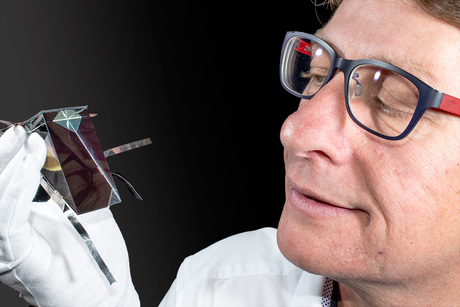A new world record in solar cell efficiency

A new solar cell configuration developed at the University of New South Wales (UNSW) has pushed sunlight-to-electricity conversion efficiency to 34.5%, establishing a world record for unfocused sunlight and nudging closer to the theoretical limits for such a device.
The record was set by Dr Mark Keevers and Professor Martin Green, from UNSW’s Australian Centre for Advanced Photovoltaics, using a 28 cm2 four-junction mini-module embedded in a prism. They were supported in their efforts by PV module manufacturer Trina Solar, the US National Renewable Energy Laboratory and $1.4 million in grant funding from the Australian Renewable Energy Agency (ARENA).
The mini-module combines a silicon cell on one face of the glass prism with a triple-junction solar cell on the other. The triple-junction cell targets discrete bands of the incoming sunlight using a combination of three layers: indium-gallium-phosphide, indium-gallium-arsenide and germanium.
As sunlight passes through each layer, energy is extracted by each junction at its most efficient wavelength while the unused part of the light passes through to the next layer, and so on. Some of the infrared band of incoming sunlight, unused by the triple-junction cell, is filtered out and bounced onto the silicon cell, thereby extracting just about all of the energy from each beam of sunlight hitting the mini-module.
“Extracting more energy from every beam of sunlight is critical to reducing the cost of electricity generated by solar cells as it lowers the investment needed, and delivering payback faster,” said Dr Keevers.
The result is almost 44% better than the previous record, made by Alta Devices in the US, which reached 24% efficiency over 800 cm2. Furthermore, the UNSW researchers believe they are within reach of scaling up their result to 800 cm2. The theoretical limit for their four-junction device is thought to be 53%, which puts the UNSW result two-thirds of the way there.
“What’s remarkable is that this level of efficiency had not been expected for many years,” said Professor Green. “A recent study by Germany’s Agora Energiewende think tank set an aggressive target of 35% efficiency by 2050 for a module that uses unconcentrated sunlight, such as the standard ones on family homes.
“So things are moving faster in solar cell efficiency than many experts expected, and that’s good news for solar energy.”
Multijunction solar cells of this type are unlikely to find their way onto the rooftops of homes and offices soon, as they require more effort to manufacture and therefore cost more than standard crystalline silicon cells with a single junction. But the UNSW team is working on new techniques to reduce the manufacturing complexity and create cheaper multijunction cells.
Furthermore, the spectrum-splitting approach is suitable for solar towers, like those being developed by Australia’s RayGen Resources, which use mirrors to concentrate sunlight which is then converted directly into electricity. The UNSW team is currently working with RayGen to explore how the advanced receiver could be rolled out at concentrated solar PV power plants.
$25m grant supports cleaner cement production
The upgrades will enable the Berrima Cement Works kiln to source up to 60% of its energy from...
$39m boost to NSW's EV fast charging network
Applications are open for Round 4 of the NSW Government's EV fast charging grants program,...
Agreement unites clean energy providers
Wind and water energy come together as Aula Energy signs a long-term power purchase agreement...










